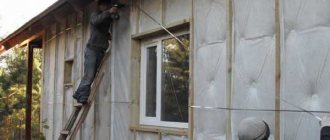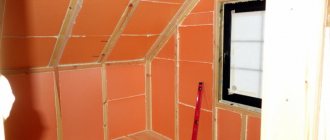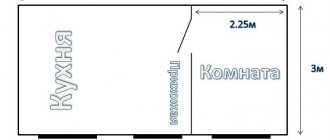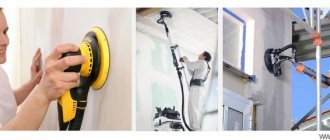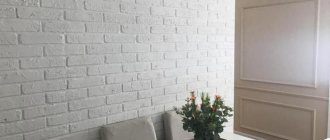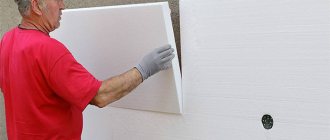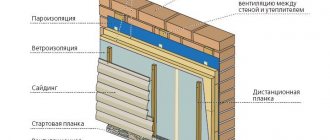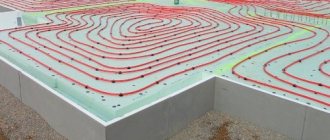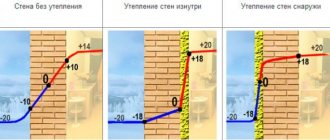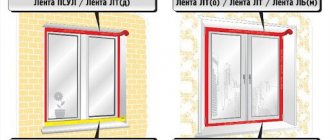Spraying polyurethane foam
The method allows for insulation of structures inside and outside buildings. This method of insulation has a number of advantages that distinguish it from all others:
- PPU firmly adheres to any surface, regardless of the material. The geometry of the surface does not matter.
- No preliminary preparation of the spraying object is required. It is enough to remove dirt and dust.
- Not afraid of seasonal temperature fluctuations.
- Unaffected by precipitation.
- The lightness of the material means that there is no additional load on the object, which allows you to spray polyurethane foam everywhere without restrictions.
- This insulation option further strengthens the structure.
- The absence of seams and joints that can reduce the thermal insulation properties.
- Due to technical features, it does not require additional transportation costs.
- High environmental safety.
Spraying of polyurethane foam is carried out using special equipment. There are many varieties of such construction equipment for use on an industrial scale and for personal use.
Advantages of polyurethane foam insulation
- High-quality heat and noise insulation - thanks to the porous structure of the material.
- The absence of joints and seams means a minimal likelihood of “cold bridges” appearing.
- Fluidity - can be applied to surfaces of any shape.
- Versatility - adhesion to almost any material (except polyethylene).
- Long service life - thermal insulation properties begin to decline only after 25 years.
- Self-extinguishing - PU foam does not support combustion.
- Quick work - applying polyurethane foam does not require serious preparation.
- Low hygroscopicity of the finished layer - additional waterproofing is required only when insulating with open-cell polyurethane foam.
Work of specialists
This is the best way out. Companies that spray foam foam use high-power foam generators equipped with a vortex chamber, where a pressure of up to 140 atm is created. The finely dispersed mixture resulting from the chamber exits forms a quickly forming layer of insulation.
It is with the help of powerful foam generators that thermal insulation is produced from high-density polyurethane foam of 40, 60 and 80 kg/m³. Today, such material is used in production and in the construction of frame houses, where 50 mm of polyurethane foam replaces 110 mm of brick wall.
As a rule, if thermal insulation is carried out by specialists, the owners only have to prepare the surfaces for their arrival. The wall, partition or ceiling requiring insulation must be dry and clean. It is necessary to remove debris and remove patches of peeling paint. For better adhesion (sticking) of polyurethane foam, the surface temperature should be at least +10˚.
Polyurethane foam is applied quickly. After just 20-30 seconds, the insulation expands to the required volume and begins to harden.
Thermal insulation with polyurethane foam
Do-it-yourself insulation of the walls of a house with polyurethane foam can be done both outside and inside.
Also, such work can be carried out directly during the construction of a house or independently - during renovation. In addition, polyurethane foam is suitable for insulating both the entire structure and its individual elements. But in each of these cases, the owners must take into account all factors related to the climatic conditions of the area of residence, the level of humidity inside the premises, the thickness of the load-bearing beams and walls, and so on.
The cost of equipment for spraying polyurethane foam with your own hands
The spread of portable installations for independent work with polyurethane foam is explained by the fact that in private homes the area for insulation can be quite small. Teams of professional workers with expensive equipment simply do not go to such sites, since it is unprofitable. In other cases, small jobs will be very expensive due to the time-consuming assembly of the installations. Disposable kits are designed for safe use by hobbyists. In areas less than 20 m2 they prove advantageous.
The average cost of a one-time installation is from 16 to 30 thousand rubles. It contains approximately 1 m 3 of polyurethane foam. The same volume of composition purchased from a specialized company will cost more than 30 thousand rubles. The benefits of working independently are obvious.
Insulation of walls outside
You can insulate the outside walls of your house with polyurethane foam with your own hands.
The most positive reviews are left about the insulation of attics, loggias and balconies with polyurethane foam. External work is also recommended for thermal insulation of the walls of residential buildings on one floor and projects for industrial or administrative use. Insulating the walls of a house from the outside using polyurethane foam includes the following steps:
- preparation of the wall surface; polyurethane foam spraying; reinforcement with a special screed; final finishing work.
Preparatory work for working with polyurethane foam outside is just cleaning the walls of the house from the old coating: paint, plaster or wallpaper. This is necessary for the highest quality and reliable adhesion of polyurethane foam. There is no need to level the walls the way that insulation with your own hands from the inside requires.
Foam foam is sprayed onto the cleaned surface. The thickness of the heat-insulating layer can be changed as needed, leveling out all surface defects.
After this, a reinforcing coating is applied to the walls. This stage of insulation requires fiberglass mesh with small holes. Such protection cannot be less than 60 mm, otherwise it may not be possible to lay any finishing material on top: siding, slabs, lining or chipboard.
Important! Both when insulating the house externally and when working from the inside, you should ensure that drops of polyurethane foam do not fall on other surfaces: it is almost impossible to clean it even with acetone.
When doing DIY work, we must not forget that even the most reliable insulation outside or inside rooms may be useless if all old windows and doors are not replaced. In this case, liquid polyurethane foam can also be used, as it can perfectly cover hard-to-reach areas around openings.
A warm home is the main goal in the life of any person. Under the influence of seasonal climatic conditions, the house ages over time and, accordingly, requires additional thermal insulation of the external walls. To insulate them, loose, fibrous and rigidly foamed polymer heat insulators are currently used. The method of insulating walls with polyurethane foam is reliable, effective and durable. At the moment, the greatest demand among consumers is polyurethane foam, which comes in both liquid and tile versions. Liquid polyurethane foam is a type of gas-filled plastic.
Its structure consists of small closed cells containing carbon dioxide. It is prepared immediately before the start of wall insulation work, which saves transportation costs. Thanks to this, as well as its multiple positive properties, this building material is the most popular. Before insulating with liquid polyurethane foam (PPU), you need to familiarize yourself with its technical characteristics and technology of use for outdoor work.
Ready-made kit for spraying polyurethane Foam Kit
A disposable system for insulating polyurethane foam, Touch*n Seal Foam Kit, manufactured in the USA, is presented in the following configuration:
- 2 cylinders, sufficient for private use, filled with polyurethane foam.
- Hose – 4 m.p.
- Spray gun - “pistol”.
- Nozzles 8 pieces - 4 each, for flat and round pressure.
Hoses are connected to the cylinders, a suitable nozzle is put on the gun, and the gun is mounted to the hose. Several disposable attachments allow you to take breaks while working. The kit is usable for a month, from the first opening. The layer hardens in 1 – 2 minutes. Excess will be removed after hardening.
Insulation of residential buildings
and buildings for industrial or commercial purposes, experts recommend equipping them only on the outside. However, installing insulation on an external wall is not always possible.
Reasons
there may be several - from a ban by city authorities to technical difficulties that arise during the installation process itself.
In such cases, the option of internal insulation
subject to choosing the right material for insulation.
Among the few disadvantages of polyurethane foam
Most often, the high cost of the material required to perform thermal insulation work, equipment and the services of relevant specialists is mentioned.
However, upon detailed analysis
each of these disadvantages turns out to be only a small problem that can be solved without much effort. Thus, the risk of destruction of the coating under the influence of ultraviolet radiation is eliminated by cladding using lining or drywall.
Acquisition costs
polyurethane foam and spraying equipment pay for themselves due to the reduction in the amount invested in paying bills and purchasing medications, as well as the absence of the need to change the insulation two or three years after installation.
The thermal insulation layer obtained thanks to sprayed polyurethane foam will last at least five decades
, and its properties (high strength, moisture resistance, non-toxic, environmentally friendly), structure and shape remain the same as immediately after installation.
As an added benefit
It is worth mentioning the significant savings in space consumed when using other types of insulation. As for the costs of specialist services, they can also be eliminated if you do the insulation yourself.
For even more savings
, you should not purchase large volume cylinders. An intentional or forced break in work exceeding 1 month leads to the need to purchase a new spraying installation. The device, which was in operation, becomes unusable.
Characteristics of sprayed insulation
It is worth noting that, as with other types of insulation, it is recommended to place the insulation on the outside of the walls. With internal insulation, freezing of the external wall is possible. Depending on the type of material, it will be able to withstand several cycles of freezing and thawing, but the service life will most likely be reduced to 10 years or less.
External PPU insulation will require external final finishing, since without it the building will look repulsive. But this is compensated by high-quality heat retention and a long service life of the house.
With the roof the situation is somewhat simpler. The materials used to cover it are initially designed to withstand the possibility of repeated freezing. This means that it is quite possible to insulate the roof with polyurethane foam from the inside. Including the reverse side of the roof covering, as well as the sheathing.
Separately, it is worth mentioning the level of thickness of polyurethane foam. Usually the thickness is significant. The standards are 2-3 centimeters, but in practice it should be 5 centimeters or more. This trick ensures that the dew point is located in the thickness of the insulator, and not on the wall itself. In this case, there is absolutely no moisture condensation, and any excess moisture easily evaporates under the influence of natural factors.
How polyurethane foam is made: basic principle
The production of polyurethane foam involves a very complex technological process. The PU foam mass is formed as a result of the reaction between a polyol and a diisocyanate or polymer isocyanate in the presence of certain catalysts and other additives. Since the polyurethane foam itself must be produced immediately before pouring or spraying, the manufacturer supplies two phases of the polyurethane foam mixture in separate containers. The phases are mixed in special installations before performing work. Here's what happens when the two phases mix:
Due to the variety of isocyanates and the huge range of polyols, polyurethanes with different properties and applications can be obtained. It can be elastic foam, rigid foam, elastomer, etc. It is impossible to find out everything about the production of polyurethane foam, since the exact formulation of the phases is kept secret by the manufacturers. Even if all the necessary components are available, an experienced chemist will have to select the necessary proportions for a long time to ensure the required properties of the mixture.
Polyurethane foam as the best wall insulation
Polyurethane foam, or, as it is often called, PPU, is a modern polymer compound used in construction as waterproofing and insulation for ceilings and walls.
Polyurethane foam is applied in two ways - spraying and pouring. When using polyurethane foam as insulation, the most complex relief surfaces can be treated by spraying. With the pouring method, polyurethane foam is often pre-placed in special molds, which are then used as a material for wall insulation.
Polyurethane foam spraying technology
Before insulation is carried out by spraying polyurethane foam, you need to prepare the surface to be treated. To do this, clean it from dirt and dry it well.
It is important to remove all rust from metals and degrease them. Aluminum requires mandatory coating with a primer with a high degree of adhesion, this will help increase the adhesion of the insulation to the surface
The temperature of the environment and components plays an important role in the spraying process. To obtain a highly effective layer, the composition must be from 10 to 25 ° C
The optimal temperature for the room is above +5 °C. Work in a colder environment can only be done with a solution heated to the desired state.
Spraying of polyurethane foam, reviews of which are almost always positive, is carried out under pressure above 100 atmospheres. Approximately two seconds after spraying, a foaming reaction occurs, followed by hardening of the composition. The resulting layer provides excellent thermal and waterproofing.
Safety of PPU wall insulation
Polyurethane foam is a completely safe chemical compound that, when heated, does not emit any harmful substances and does not pollute the environment or human health. After insulating the walls with polyurethane foam, your home will remain just as reliable and safe, only it will become much more pleasant to be in.
Insulation of external walls with polyurethane foam
Polyurethane foam, as almost all reviews say, is the most popular modern material both for insulating buildings with your own hands from the inside and for carrying out external work. Thanks to it, owners can save not only on heating: all repairs will be inexpensive. PUF is prepared right before application to the surface, which means there is no need to spend money on transporting this polymer to your home.
Thermal insulation of a house using polyurethane foam
The technology of insulating a house with polyurethane foam is valued for its efficiency and speed, meeting safety standards, and excellent insulating properties.
It is suitable for any external and internal structures, including loaded ones, the only limitation of application is the high price. Reviews from building owners are mostly positive; many are thinking about purchasing equipment.
Among the noted advantages are high adhesion, the absence of cold bridges, the ability to process complex and hard-to-reach areas, strength and resistance to moisture and fungus.
Features of polyurethane foam
The technology is relevant for any building surfaces, including metal. Moreover, it successfully protects the latter from corrosion by forming a film directly on the area in contact with the pipe or fittings.
Cured foam is completely impenetrable to external influences and is only afraid of mechanical damage and UV rays. There are two varieties: with an open and closed cell structure; in the cold climate of the Russian Federation, the second, more expensive and dense, is more often used for construction purposes.
This type of polyurethane foam belongs to the class of materials that are difficult to ignite and prevents the spread of flame.
Density is a controlled indicator, on which the cost of spraying polyurethane foam directly depends.
Changing the chemical composition and equipment settings allows you to vary this characteristic from 15 to 80 kg/m3 (it can be higher - up to 300, but according to reviews this is not necessary), which is important when insulating structures with varying degrees of load.
There is a clear relationship between the volume of foam formed and the ambient temperature (with the same insulation thickness, 17% more components are consumed); in the cold season, additional heating is required.
PPU with a closed structure has vapor permeability close to zero, this limits its use in internal insulation schemes. In any case, it is not recommended to completely cover both the floor and walls with it in unventilated rooms. As an option, a composition with a density below 12 kg/m3 with open cells and appropriate vapor and waterproofing is used.
Technology and basic circuits
Work on insulating polyurethane foam begins with choosing its density, taking into account the load-bearing capabilities of the structures and the thickness of the future layer according to the climatic conditions of the region. When doing it yourself, it is recommended to adhere to the following scheme of actions (using the example of a facade):
- Surface preparation: applied to stable, clean and dry structures, heated if necessary. Evenness does not play a special role, but there should be no peeling pieces of the old coating.
- Installation of sheathing (recommended). Theoretically, a frame is not needed, but installing guides helps control the level and facilitates the finishing process. The height of the sheathing is selected taking into account the future thickness of the insulation.
- Application of polyurethane foam: in a thin layer (no more than 5 mm) in the direction from bottom to top. If necessary, the process is repeated.
- Upon completion of the polymerization process, excess foam is cut off along the guides and external finishing is carried out. To plaster polyurethane foam, a chain-link mesh must be placed (similar to polystyrene foam, secured to the sheathing or material). The easiest way is to cover the facade with siding, clapboard, or, if you have an unlimited budget, to cover it with brick.
This guide is also suitable for roofs or floors on joists; experienced operators use up raw materials without leaving a trace, even without lathing.
It is allowed to use polyurethane foam in systems with heating elements (both pipes and cables); it is believed that such insulation reduces space heating costs.
When insulating pipelines, containers or metal walls, the preparatory stage includes the removal of old flaking paint and rust. A mandatory step in any scheme is sealing and hiding from ultraviolet radiation.
Application technology
The most common method of polyurethane foam insulation is spraying onto the structural elements of the building.
PPU is sprayed onto the walls.
But there is another way - pouring, which requires a space closed on all sides. It is mainly used in factories producing sandwich panels.
Filling with polyurethane foam.
On the floor
Before spraying insulation on the base of the floor, preparatory work is carried out, including: removing the old screed, repairing the concrete base (in a wooden house the subfloor is being restored), waterproofing the ceiling or subfloor. The preparatory process is described in more detail in the material “Preparing the floor for pouring screed.”
A lathing for laminate, parquet, linoleum or joists for floorboards is mounted on the prepared surface. At the same time, both the sheathing slats and the joists should be 20-30 mm higher than the insulation. The gap is necessary to ensure ventilation.
On the walls
The technology for insulating the facade and walls from inside the room is the same. Consists of sequential operations:
- the old finish is removed from the surface of the walls (you can see how to quickly remove it in the work “Aligning walls for painting”);
- the sheathing is installed;
- polyurethane foam is sprayed. In this case, special attention must be paid to corners, crevices and voids;
- areas with protruding insulation are trimmed with a knife (easy to detect as a rule);
- Drywall is attached to the sheathing for finishing with wallpaper, painting or decorative plaster.
To the ceiling
Insulation of the PPU ceiling is carried out under a suspended or suspended ceiling. In this case, the old finish is removed from the surface of the floor slab, after which foam is applied in a thin layer (lathing is not required).
On the roof
The roof is one of the few places in the house where you can do polyurethane foam insulation work yourself. To do this, you need to buy special kits with 2 small cylinders and a sprayer. The containers contain the starting reagents, and a sprayer is needed to mix the components. But before starting work, you need to calculate the financial costs so that the roof does not literally turn out to be golden.
Semi-professional kit for PPU insulation.
Preparing the roof for insulation is simple: the surface is dust-free and dried. PPU is applied from the inside between the rafters. After the foam has hardened, the thermal insulation layer is covered with sheets of plywood or OSB.
PPU roof insulation scheme.
The editors of the portal StroyGuru.Com tried to objectively talk about such a controversial insulation material as polyurethane foam. Having complete information about the material, you can make an informed choice and avoid mistakes.
Characteristics of polyurethane foam
PPU is popular not only because applying polyurethane foam with your own hands is a fairly simple process. This material has excellent characteristics:
- thermal conductivity coefficient 0.019-0.028 W/m*K;
- vapor permeability tends to zero;
- density 30-60 kg/m. cube;
- does not burn - according to GOST 12.1.044 it is classified as low-flammable materials;
- does not absorb moisture - the percentage of closed cells is from 85 to 95.
This also applies to the insulation of frame walls with expanded clay. In addition, it is quite heavy.
It has good adhesion (adhesion) to all materials. Thanks to its almost complete waterproofness, polyurethane foam protects metals from corrosion. In the characteristics of polyurethane foam there is also such a thing as start time. This is the number of seconds it takes for foaming to occur. The start time for different types of work is slightly different. For horizontal surfaces, the foaming time should be about 5-10 seconds. For ceiling insulation, this period is reduced to 3 seconds.
Equipment for applying polyurethane foam
Installations for spraying polyurethane foam come in high and low pressure. The main elements are a compressor and a spray gun, in which the PPU components are mixed. In low pressure equipment, mixing occurs at 5-10 atmospheres, and in high pressure equipment - at 100 atmospheres or more.
Different pressure affects the mixing method:
- at low pressure the components are mixed by swirling;
- at high pressure, mixing occurs through the diffusion of components.
And the leader in this niche is Rocklight stone wool insulation, made from basalt.
Low pressure units are smaller, cheaper, and easier to operate. In them you can set mixing proportions (1:1 or 1:2) and smoothly adjust productivity directly during operation. High-pressure units allow you to create a more even layer of thermal insulation; you can work at a distance of up to 125 meters from tanks with mixed components. The productivity of such equipment is significantly greater (up to 500 square meters in 8 hours). These are professional installations, which is why they are quite expensive.
Disadvantages of polyurethane foam insulation
- Compliance with technology directly affects the quality of insulation and the service life of the finished coating. Therefore, work should be carried out by experienced craftsmen using high-quality components and certified equipment.
- Polyurethane foam does not burn in the direct sense of the word, but during a fire the material emits very acrid smoke. This can be dangerous to health and even life.
- Under the influence of ultraviolet light, the hardened foam changes color - from white it becomes dark brown.
- The cost of the service can be quite high. The lowest price per m2 is for lightweight open-cell polyurethane foam, but it cannot be used in all cases.
DIY polyurethane foam spraying
All work must be carried out in good weather. High humidity outdoors and indoors at this time can slightly damage the polyurethane foam. Do-it-yourself spraying needs to be done in several layers. This is one of the main principles of work.
Insulation with polyurethane foam by spraying begins with complex surfaces: chimneys, ventilation hatches and pipelines. At the same stage, you need to close all the joints that go out. It is advisable to apply the first layer with a thickness of approximately 14 mm. After it hardens, you can begin further work.
The second and third layers are applied to each other with a short time interval. It is optimal to carry out all work in one day. If this is not possible, then, starting each subsequent layer, you need to carefully prepare the surface. With proper planning of working hours, insulation of a medium-sized private house can be completed in 2-3 days.
The most effective sound and heat insulation is considered to be a structure consisting of three layers.
Advantages of polyurethane foam
Polyurethane foam is easily applied to the surface of the walls.
PPU will cost owners less than simple extruded polystyrene foam. But not only its price plays a major role: costs are reduced due to the absence of complex transportation.
Also, the technology of spraying polyurethane foam onto the surface that needs to be insulated makes it possible to significantly save time on DIY work. In addition, there is no need to use adhesives: the polyurethane foam is rigidly attached to itself.
Thus, the following advantages of this insulating material can be noted:
- quite high adhesive characteristics, which appear immediately when sprayed onto building elements; the formation of an insulating layer without seams, which helps strengthen and increase the reliability of the roof, walls and other parts of the structure; Insulating walls with polyurethane foam has a large number of advantages. low thermal conductivity; low weight, especially important when insulation of an old house; tensile-compressive strength, which is associated with the cellular structure of the polymer; durability: more than 50 years of service in the absence of mechanical damage; fire resistance; no need for vapor barrier due to the density of the material and hermetic structure; wind insulation; resistance to rotting, mold and inaccessibility to rodents and insects; very low moisture absorption; reliable sound insulation; lack of toxicity and safety for human health; affordable price.
I use polyurethane foam to insulate walls and you save money.
The thermal conductivity of polyurethane foam fluctuates around 0.023 W per cubic meter: this is almost one and a half times less than that of extruded polystyrene foam. Moreover, the density of the material and its thermal insulation properties are such that a layer 50 mm thick is equivalent to an 80 mm layer of the same foam plastic and a 150 mm layer of mineral wool.
The fire resistance of polyurethane foam is also superior to almost all insulation materials: its ignition is possible only in close contact with fire, and the attenuation of this open flame leads to the cessation of combustion of the heat-insulating layer.
PENA-mini B2 Russia vs PPU Foam Kit USA cylinders
We planned for our PPU household device, like the American one, to work on the “Touch and Seal” principle, i.e. "Touch and isolate." But it was not possible to copy the Yankees 1 to 1.
In fact, there are three differences. One is negative and two are positive. Read on and decide for yourself what is better to buy for thermal insulation of polyurethane foam with your own hands: American or Russian cylinders.
PENA-mini B2 is inferior to the American Foam Kit in that imported cylinders do not require a source of compressed air. Containers with components A and B are already under pressure. Therefore, to get started, just connect the sprayer, open the valves on the cylinders and spray. The “Touch and Seal” principle in the truest sense of the word.
Our device requires compressed air, i.e. small household compressor. It is needed to create excess pressure in the cylinders. Americans pump gas into cylinders with polyol and isocyanate and seal them somewhere in Florida or California. And to a Russian in Samara or Barnaul who decided to insulate a balcony, garage, etc. with PPU with his own hands. no compressor needed. That's a plus.
If suddenly there are not enough components in the cylinders, then you need to go to a gas station. The closest ones to Samara are located in Florida, Georgia and South Carolina. California or Arizona will be more convenient from Barnaul. Or, without leaving Russia, you can always buy another new Foam Kit kit.
FOAM-mini B2 is superior to imported Foam Kit in that our installation is REUSABLE. PENA-mini B2 cylinders are filled with PU foam immediately before work, on the balcony of a house in Samara or a garage in Barnaul.
From one canister we pour component A into the first cylinder, from the second - component B into the second. And now, to get to work, you need to create excess pressure in the cylinders. This function is performed by the compressor.
Yes, a domestic product requires a source of compressed air, but the components can be added to the cylinders and used repeatedly. American cylinders are disposable.
FOAM mini is also better because it is cheaper. Domestic cylinders and components for refilling them are cheaper than imported Foam Kits.
American cylinders are expensive and can only be used once, i.e.: sprayed and thrown. Therefore, the motto Touch and Seal in relation to Russia can be clarified: Touch, Seal and Threw.
The NST company offers a reusable device PENA-mini B2 for insulating polyurethane foam with your own hands and raw materials for self-refilling.
Internal insulation of building walls with polyurethane foam
Apartments in city high-rise buildings are usually insulated from the inside using polyurethane foam. Most often, only the rooms most exposed to noise and cold from the street are thermally insulated. As a rule, these are corner parts of premises, areas near loggias, walls separating two apartments or facing the road from the outside.
There are also frequent cases when owners decide to insulate a kitchen or bathroom with polyurethane foam from the inside with their own hands.
Important! In this case, it is necessary to create a vapor barrier, which is usually omitted if the insulation is carried out using polyurethane foam.
The film is installed on the heat-insulating layer so that the shiny (foil) side is on the inside. In addition, the room requires a high-quality ventilation system.
Types of polyurethane foam and areas of application
- Open cell (elastic), with a density of 10-20 kg/m³;
- Closed cell (hard), with a density of 20-30 kg/m³ and higher, up to 80 kg/m³.
Polyurethane foam will perfectly protect the room from heat loss and also cope with its waterproofing.
In elastic polyurethane foam, up to 90% of the cells are open. Its low density gives it a certain stretchability. In hard polyurethane foam, up to 98% of the cells are closed. This and its high density make it an unusually strong insulating material.
Different types are used in different fields. If we are talking about spraying on a material that can change its size - for example, metal structures that contract and expand with temperature changes - then elastic polyurethane foam is used. It is indispensable for waterproofing, for protecting the connection between the wall and the roof, for spraying on wooden and metal surfaces that come into contact with cold air from the outside of the building.
Closed cell (rigid) polyurethane foam is used for internal insulation and outdoor work. It is usually sprayed on surfaces made of concrete, cement and brick. Closed cell polyurethane foam is also used when they want to give the structure frame additional rigidity. Its high strength allows you to significantly strengthen unstable elements. Both types of polyurethane foam have many advantages, but very few disadvantages.
2How to spray polyurethane foam?
This type of insulation is characterized by a high level of adhesion. It can be applied to the surface of walls without pre-treatment.
It is important to remember that the spraying process must begin after the installation of the frame for the next sheathing has been completed.
For good insulation, it is enough to apply a layer of the substance equal to 1-2 centimeters. However, such a parameter is selected after preliminary calculations have been performed in advance.
In order to apply two-component polyurethane foam, you need to use special equipment, but before that you need to carry out preparatory work.
First, a frame for future cladding is installed on the prepared wall surface. Electrical wiring is attached to the outer surface of the walls.
It is recommended to perform these works using a protective sleeve for the wire. In the future, this will help to quickly replace those sections of the network that are damaged. The process of spraying the insulation is carried out using a spray gun.
At the very beginning, all voids located under the frame profile are carefully processed. When expanding, the foam material is able to completely fill all voids with a high degree of efficiency. Then you need to move on to covering the main surface of the wall.
Insulating a house with foam
The substance expands within 0.5-1.5 minutes. If the thickness of the layer is unsatisfactory, you can arrange for re-application of the material and add foam insulation.
Spraying is best done several times. The result will be a seamless coating that will have high thermal performance.
It is worth noting that in the case when polyurethane foam is used, there is no need to provide additional vapor barrier measures.
After this, the layer of polyurethane foam that was applied to the wall is covered with ordinary plaster.
An adhesive mixture is applied to this layer, and then a reinforcing mesh is applied, which is again covered with a layer of glue. After the surface is completely dry, it should be sanded using a mesh.
What is polyurethane foam?
Few people know, but polyurethane foam (PPU), which is in demand today, was manufactured back in the last century. It was first used as thermal insulation in 1957. Since then, it has not only not lost its relevance, but has also begun to be used in other areas far from construction. It is polyurethane foam that is one of the fillers in upholstered furniture, children's toys, etc. What is polyurethane foam?
At its core, polyurethane foam is one of the types of plastics. The uniqueness of the material lies in the fact that the main percentage of the substance is gas bubbles. According to studies that have been repeatedly carried out with the finished product, modified plastic in the finished product is only 10-15%. The rest of the space is occupied by gas bubbles. As a result, the material acquires special thermal insulation and performance characteristics.
. Namely:
- A 3 cm layer of polyurethane foam is identical in thermal conductivity to 7 cm, 16 cm mineral wool, 38 cm foam block and 1 m 70 cm brick wall.
- The material can be prepared directly at the construction site or purchased ready-made mixture in cylinders.
- Tests have shown that polyurethane foam retains its performance characteristics over a range of - 150° to + 220°.
- Has high adhesion to any surface
. Using polyurethane foam you can even insulate a metal structure. - After drying, the surface can be plastered or used as a base for laying ceramic tiles.
You need to know that there are several methods of insulation using polyurethane foam. You can purchase sheet material, prepare a two-component composition yourself, or use a ready-made mixture sold in containers resembling polyurethane foam.
Polyurethane foam on shelves
The technology for insulating walls with polyurethane foam is quite simple.
Insulation with polyurethane foam spraying is the creation of a layer of thermal insulation.
Moreover, this method can be used on almost a wide variety of surfaces: smooth, textured or having an unusual shape.
The material is usually applied by spraying, but pouring is also possible. In a special device, two polymers are mixed in the liquid phase: polyisocyanate and polyol. At the same time, they are foamed due to carbon dioxide and heated to a fairly high level.
This entire mixture is fed into a spray gun or mixer, which is applied under high pressure to the elements of the insulated structure. Polyurethane foam is poured into molds in which the material hardens before use.
Our work on this service
Thermal insulation of garage walls 125m2 Elektrougli
Pouring polyurethane foam into facade voids in SNT Desna-Gorodishche
Pouring polyurethane foam into the facade of a private house in Moscow
Pouring polyurethane foam into the facade of a private house in the village of Tuchkovo
Calculation of the thickness of the polyurethane foam layer
Taking into account the cost of spraying polyurethane foam, it is necessary to choose the optimal layer thickness so as not to overpay for excess material consumption. Insufficient insulation is not effective. For the calculation, it is necessary to take into account such aspects as:
- Climatic zone;
- Seasonality of building operation;
- Indoor humidity;
- Material of insulated walls.
When making your own calculations, you need to use the recommendations of SNiP 02/23/2003; SP 23-101-2004 and GOST R 54851-2011. When insulating walls from the outside, you can use the formula: R = d / ʎ, where R is the thickness of the spraying, d is the thickness of the layer, converted to meters, and ʎ is the thermal conductivity coefficient W/(m•K).
Liquid insulation for walls: main characteristics
Polyurethane insulation is applied to the walls by spraying using special equipment. Therefore, most often such work is entrusted to specialists, but every homeowner can cope with this task independently, but subject to mandatory compliance with safety precautions and the use of special equipment and personal protective equipment.
In addition to spraying, which is performed mainly on vertical surfaces, the pouring method is sometimes used, but in this case only horizontal planes can be processed, and insulation can also be made by pouring it into pre-prepared molds.
Polyurethane is especially indispensable for insulating various voids, the insulation of which is practically impossible using traditional materials.
For example, often when installing window structures and doors, foam is used to insulate walls in cylinders , the application of which allows you to ideally seal the opening and protect the room from cold and noise.
Properties and characteristics
Liquid polyurethane foam is considered one of the best materials for insulating external and internal walls. This is due to a number of advantages and technical characteristics of the material:
- high heat resistance, due to which the material retains and retains heat indoors;
- the lightness of polyurethane foam allows it to be used for insulation of any surfaces, even vertical and ceiling ones;
- installation of foam is quite simple; even an inexperienced builder can cope with this task;
- elastic polyurethane foam sheets have high sound insulation and help protect housing from extraneous noise, pipes, neighbors, weather conditions, etc.;
- the material is highly resistant to various types of chemicals; it cannot be destroyed by oils, gasoline, alcohol or concentrated acids.
In addition, it is important to note that PU foam sheets are available in a wide range and differ in density, thickness, elasticity and dimensions.
The durability of the material depends on these characteristics, and polyurethane foam can last from 20 to 50 years. Due to its technical characteristics, polyurethane foam has a number of advantages over similar materials that are used for insulation and sound insulation of walls, floors and ceilings:
- the material is very light in sheets, so there are no problems with its transportation;
- the insulation in the cylinder is made (installed) on site and does not require transportation costs;
- due to its lightness, polyurethane foam can be used for insulating ceilings;
- when using balloon foam, there are no joints and a solid heat-insulating sheet is created;
- easily attaches to any surface, regardless of the texture of the base;
- The material is resistant to rotting, growth of fungus, mold, and other parasites.
Like any other building material, polyurethane foam, in addition to its advantages, has some disadvantages that you need to familiarize yourself with before using it:
- Polyurethane foam can be destroyed when exposed to direct sunlight, so it is recommended to protect the insulation with a finishing material, for example, paint or plaster, which will not allow ultraviolet radiation to penetrate;
- polyurethane foam is not a flammable material, but it smolders when exposed to high temperatures, so it should not be used near an open fire or in places of high heat.
Why is polyurethane foam suitable for insulating hangars?
In fact, you should take into account the fact that hangars have a very complex structure, but polyurethane foam is designed to fit any shape and area, which allows you to easily install thermal insulation.
Also, the use of polyurethane foam for hangars acts as additional protection, given that hangar structures are quite lightweight.
Direct delivery is considered a huge advantage in choosing polyurethane foam. In order to deliver the necessary material to the construction site, there is no need for any specialized equipment.
Thus, we understand that by insulating a hangar with polyurethane foam, we spend significantly less money in the future on electricity, which will be used to heat or cool the room.
Recently, insulation of a balcony or loggia has become increasingly important.
- But, before achieving the most comfortable conditions, you need to clearly understand how to achieve this result and through what means.
- When you finally decide to take such a step, you will certainly be faced with a huge assortment of building materials for insulating rooms.
- In order for thermal insulation to be of the highest quality and efficiency, it is necessary to take into account the angles of the structure. Although for polyurethane foam this is not necessary, because the application of this material is as simple and comfortable as possible.
- Also, one of the important factors that should be taken into account when choosing a particular material is the level of environmental friendliness. In this choice, we give our preference to polyurethane foam, which is made from the most environmentally friendly hypoallergenic materials and contains vegetable oils.
- The main advantage of polyurethane foam is its low weight, which strengthens the structure without making it heavier. Also, this material does not allow for the occurrence of any moisture, which is a huge plus and a distinctive feature among other building materials.
- Polyurethane foam is a harmless material, due to which a person is not subject to allergic reactions and toxic effects on the body, which is excellent for residential premises.
- Also, a characteristic feature of polyurethane foam is that the material is not exposed to any external influences, including temperature changes, natural factors, etc. This feature greatly simplifies the choice of insulating a balcony or loggia.
- The method of applying polyurethane foam is one of those features that is not only easy to use, but also very effective. When spraying the material on the surface, any seams, irregularities and gaps that could lead to heat loss are eliminated.
- The main feature of this material is considered to be its service life, which reaches 50 years. Thanks to its high-quality composition, polyurethane foam is not subject to deformation and does not lose its properties and quality.
What is polyurethane foam
The first samples of the material were obtained in the 30s of the last century. By mixing polyol and polyisocyanate under various conditions, the researchers obtained:
- elastic and flexible samples with low density, called foam rubber;
- solid, durable, but non-flexible samples are the prototype of modern polyurethane foam and polyurethane foam insulation.
The cellular structure of the material serves as a barrier to the penetration of cold. Foamed and hardened polyurethane foam consists of 80-90% carbon dioxide, enclosed in thin, randomly located plastic bridges.
Do not confuse polyurethane foam with expanded polystyrene for wall insulation. Expanded polystyrene is a common foam made by polymerizing styrene with the addition of pentane as a blowing agent. The high thermal insulation properties of polystyrene foam allow it to be used for wall insulation, but there are such disadvantages as:
- solubility upon contact with technical liquids and their vapors;
- toxicity at high temperatures;
- fragility,
limit areas of application.
Foamed polyurethane does not have these disadvantages; its thermal insulation capacity is higher, so its use is more justified. The material is presented in molded form and liquid, two-component. To insulate non-linear structures and hard-to-reach places, it is advisable to use sprayed polyurethane foam.
The use of polyurethane foam is not only aimed at one area
Polyurethane foam is designed for insulation of all types of roofs.
Each of us wants our home to be as comfortable as possible at any time of the year. In our time, a similar effect can be achieved in any number of different ways, from the use of high-quality building materials in the initial stages of construction, to the installation of air conditioning systems and additional heating. Thus, in order to create the most comfortable living conditions in wooden houses, it is necessary to use high-quality insulation of walls, as well as other structures through which air can penetrate.
Insulation with sprayed thermal insulation. Polyurethane foam is recognized as the most effective material for insulating wooden structures. In our country, this method of using polyurethane foam on surfaces is not as relevant as in neighboring countries. For example, in the West, this use has been used for more than 50 years and remains the most successful. Thanks to polyurethane foam, the owner of such a house can save about 50% of the cost of heating and cooling the room.
Types of insulation: external and internal
Why is home insulation so important? The question may seem stupid, but some novice masters may ask it because they do not yet fully understand the importance of this event. And if the insulation of a garage or country house can sometimes be neglected, as well as the insulation of a building located in southern latitudes, then it is imperative to take measures to increase the level of thermal insulation of the walls of a house located in a harsh climate
Insulation of house walls from outside
So, firstly, it is worth noting that insufficiently insulated walls of any building cause large losses of thermal energy. About 45% of the heat is lost through them and goes to “heating” the street, which means that approximately the same 45% of the heat needs to be taken from somewhere to keep the house warm. And this is a significant increase in the amount of expenses for heating and heating the house, and annually. It is enough to install the insulation once during construction and forget about replacing it for many years. And the cost of heating the building will already be significantly lower.
Moreover, it is also very important to lay the insulation correctly so that cold bridges do not form, otherwise the loss of thermal energy will still be quite large
It is very important for residents of private houses to know how to insulate the outside of the house themselves.
In general, insulation can be done using two methods - both from the inside and outside the room. Deciding which method is better is quite simple. Thus, it is extremely rare to resort to laying insulation on walls from the inside, since this method has many disadvantages compared to the method of insulation from the street.
How to properly insulate walls - outside or inside?
If the house is insulated from the inside, then the wall of the building from the outside is completely unprotected from external factors, which means that the materials will be subject to attack by sunlight, cold, moisture, etc., which will significantly reduce their service life
It is also worth taking into account the so-called dew point - the place where condensation collects. When installing insulation from inside the house, it will be too close to the inside of the rooms, which means that the walls will dry out worse, dampness may form and, as a result, mold, mildew, etc.
d
It is also important to understand that insulating walls from the inside will “eat up” part of the free space, and the rooms will be smaller
Dew point
If you insulate the house from the outside, then all these negative factors can be avoided. That is, the wall from the street will be well protected from cold, light and water, and the room inside will be freer, and the quality of insulation will not suffer at all.
Insulation of house walls from the inside
Polyurethane: what is this material?
Polyurethane is obtained by mixing two components - polyol and diisocyanate in equal proportions. Initially, when working with them, you should remember their high toxicity, but after they are combined with polyurethane foam, the insulation becomes completely safe.
A special set of equipment is used to mix the two components, and the process itself is accompanied by intense gas release. The result is a material in which carbon dioxide is contained under a thin polyurethane shell, which ensures high thermal insulation characteristics of the insulation.
The thermal conductivity of polyurethane foam is only 0.023 W/m3: a layer with a thickness of only 50 mm corresponds in this parameter to 150 mm of mineral wool insulation or 80 mm of ordinary polystyrene foam.
Direct mixing takes place inside a special gun, in which the necessary pressure and temperature conditions are created, reaching 45 °C.
Only under such conditions is it possible to obtain the “correct” insulation. If the amount of diisocyanate prevails, this will lead to rapid shrinkage of the material, and accordingly, will affect the thermal insulation characteristics.
If there is more polyol, then the material will turn out to be brittle and brittle and will not be able to perform its function, since its solidity and integrity will be impaired.
If technical equipment that is unable to provide the required parameters for mixing pressure and temperature, the resulting product will have worse thermal conductivity.
Polyurethane insulation and its varieties
To insulate residential buildings and industrial buildings, two types of polyurethane can be used: with an open cellular structure and a closed one. Despite the common technical characteristics, there are also differences between these two types of material, and not only external ones.
1. Open-cell PUF, also called lightweight, has characteristics and thermal conductivity comparable to mineral wool. In addition, these two materials are comparable in hygroscopicity, which requires the use of additional protective materials: membranes or films to create a layer of hydro- and vapor barrier.
Basically, lightweight polyurethane is used for heat and sound insulation of internal partitions and ceilings, that is, in those places where the likelihood of condensation and moisture exposure is minimal.
Its use as insulation is often limited due to its higher price than mineral wool, but if the problem of sound insulation comes to the fore, then it has no competitors.
2. Closed-cell polyurethane has high adhesion to almost any surface and, therefore, has the most expanded scope of application.
Such liquid thermal insulation is suitable for walls inside and outside the house, and can be used to insulate basements, foundations, roofs, ceilings and other structural elements of buildings.
It is important to note that closed-cell polyurethane foam is represented by materials with different densities:
1. Low - from 28 to 32 kg/m3, but it should be noted that in this parameter it bypasses lightweight open-cell polyurethane, whose corresponding indicator is in the range from 9 to 11 kg/m3.
The main area of application is the insulation of walls and ceilings, onto which the material is applied in a thin layer. Effective for thermal insulation of wooden surfaces and frame houses, but in this case, possible contact with open fire should be completely excluded.
The thermal conductivity coefficient is 0.02-0.028, while the vapor permeability indicators are close to those of wood and are equal to 0.05.
2. Medium-density material with values from 32 to 40 kg/m3 is mainly used for insulating various cavities. These are the characteristics of sprayed insulation in cylinders used to seal openings.
An important operational advantage of this material is its average expansion rate, which allows it to be used for processing such spaces, as well as peeling or old surfaces.
3. High-density material has values from 40 to 80 kg/m3 and is used for surfaces that may be subject to high mechanical stress. Such insulation is irreplaceable, for example, for thermal insulation of floors or external walls.
When choosing foam insulation for your home, you should focus, first of all, on its technical characteristics and recommendations for the area of application.
If we take into account only the price factor, then the lightweight open-cell material has no competitors; in addition, this insulation also has high thermal insulation qualities, but the need for steam and waterproofing measures minimizes this advantage.
PPU insulation in cylinders. Video:
Advantages of polyurethane foam insulation
Among the main advantages of the material, in addition to low thermal conductivity, the following advantages should be noted:
- excellent sound insulation characteristics;
- moisture resistance (except for open-cell material);
- possibility of application to any type and type of surface, including curved elements and filling voids;
- creation of a heat-insulating layer without seams and joints, which eliminates the appearance of cold bridges;
- high adhesion to any surface - the only exception is polyethylene, but elements from it are rarely used as a building material;
- long service life of the insulation, ranging from 25 to 50 years or more, depending on operating conditions;
- the shortest possible time required for carrying out the work, since the application of insulation, its subsequent expansion and setting occurs quite quickly. In addition, applying insulation by spraying allows you to immediately process large surfaces;
- insulation, in addition to its main task, also performs the functions of corrosion protection for metal elements;
- the low weight of the sprayed material allows it to be used for insulation without creating additional load on the load-bearing structures of the building;
- the insulation is environmentally safe and is not subject to destruction by microorganisms, and also does not require the installation of additional wind, steam or water protection.
It should be noted that, although polyurethane foam is not a non-flammable material, its use is quite safe given its ability to self-extinguish, but it is important to remember that in such cases there is an intense release of poisonous and toxic combustion products.
In addition, you need to pay attention to its high adhesive ability, which is a boon for thermal insulation of surfaces, but in case of contamination of nearby areas that cannot be treated, it can only be removed mechanically, which leads to damage to the latter.
Therefore, before starting work, you should protect all surfaces on which spraying is undesirable.
Disadvantages of PPU
Of the negative properties of the material, it should be noted:
- relatively high price;
- the need to strictly adhere to the technology of performing the work, which creates certain difficulties when applying insulation independently;
- the lack of vapor permeability of the material requires the creation of an effective ventilation system in the room;
- vulnerability to ultraviolet radiation. All surfaces that may be exposed to sunlight must be protected with an outer layer of cladding: a curtain wall, plastering, etc.
Another significant disadvantage is the need to use special equipment and a reliable personal protective kit, consisting of a suit, respirator, and goggles.
In addition, spraying polyurethane foam requires certain skills in working with both the material itself and the equipment.
Therefore, it is often more profitable to invite professional craftsmen for this work, especially taking into account the fact that purchasing equipment for one-time use or renting it is not economically profitable, and it will not be possible to apply thermal insulation manually using auxiliary mechanisms.
But if we are talking about sealing small construction cavities or areas, then it is quite possible to do the work yourself, for example, using polynor , a sprayed material used for heat and sound insulation.
Available in cylinders and does not require special skills to use. Polinor is completely ready for use and is a material in the form of a foamed mass, in which the ratio of carbon dioxide to solid particles is 9 to 1.
The capacity of one cylinder is either 800 mm or 1000 mm - this volume of material is enough to treat an area of 1 to 2 m2, depending on the thickness of the applied layer.
When processing cavities, it should be taken into account that the insulation not only perfectly fills the space, but can also cause damage or even destruction of the structure as a result of the expansion of the material after hardening.
Therefore, such work must be carried out with the utmost care, for example, performing such foam insulation in several approaches.

